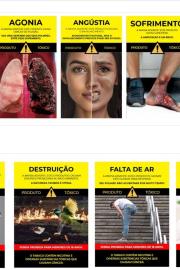
Background Singapore has implemented plain packaging, a measure that strips all colours, logos and branding elements from tobacco packs. In other countries, tobacco companies responded to plain packaging with a variety of marketing tactics. Our goal was to describe the tobacco industry’s marketing adaptations to Singapore plain packaging. Methods Qualitative analysis of 378 cigarette packs sampled from Singapore retailers in March 2019, March 2020 and January 2021, 12 months prior to, 2weeks prior to and 6months after plain packaging phase-in, respectively. For each pack, we collected descriptive information on the brand and variant name, pack and stick dimensions, pack shape, differentiating features and distinctive scents, as well as photographic data of the pack, cigarette sticks and any distinct features. We used the March 2019 collection as our baseline dataset, and March 2020 and January 2021 collections as comparison datasets to examine changes in tobacco marketing strategies just before and after plain packaging phase-in. Results Around Singapore’s plain packaging phasein, tobacco companies launched variants with flavour capsules, novelty filter features and new flavours and used more descriptive variant names reflecting the variant’s colour coding or market positioning. Tobacco companies revamped some existing variants, often with Japanese marketing themes to convey a more premium product image. After plain packaging, tobacco companies used longer packs and variations in stick length, filter length and foil texture to further differentiate products. Conclusions Following plain packaging in Singapore, tobacco companies rely increasingly on nomenclature and the cigarette stick itself to market and differentiate products
EIJK, Yvette van der; YANG, Adonsia Yating. Tobacoo Control, 2022, v. 31, p. 744–749. Disponível em: https://tobaccocontrol.bmj.com/content/tobaccocontrol/31/6/744.full.pdf. Acesso em: 28 abr. 2025.

Em 2011, 2012 e 2020, as fabricantes de cigarro dos Estados Unidos conseguiram derrubar, na Justiça, regulamentos federais que as obrigaria a colocar rótulos de advertência sanitária em maços de cigarro. Mas perderam a última batalha judicial agora, no final de 2024. A partir de dezembro de 2025, elas terão de colocar, em embalagens e anúncios, mensagens e imagens explícitas sobre os perigos do fumo.
MELO DE, João Ozorio. Após 13 anos de batalhas judiciais, maços de cigarro terão rótulos de advertência sanitária nos EUA. Consultor Jurídico, São Paulo, 4 dez. 2024. Disponível em: https://www.conjur.com.br/2024-dez-04/finalmente-macos-de-cigarro-terao-.... Acesso em: 24 dez. 2025.

A Anvisa aprovou as normas que estabelecem novas advertências sanitárias e mensagens para embalagens, expositores e mostruários de produtos fumígenos derivados do tabaco. A decisão foi tomada durante a 21ª Reunião Pública da Diretoria Colegiada (Dicol) de 2024, realizada nesta quarta-feira (30/10).
ANVISA aprova novas advertências para produtos derivados do tabaco. Agência Nacional de Vigilância Sanitária, 1 nov. 2024. Disponível em: https://www.gov.br/anvisa/pt-br/assuntos/noticias-anvisa/2024/anvisa-apr.... Acesso em: 13 nov. 2024.
Relatório sobre embalagens padronizadas
https://www.globaltobaccocontrol.org/resources/advancing-tobacco-plain-a...
Institute for Global Tobacco Control (Instituto para Controle Global do Tabaco). Promovendo embalagens padronizadas de tabaco em países em desenvolvimento: conselhos de especialistas. Baltimore, MD: Johns Hopkins Bloomberg School of Public Health; março de 2020.
Documento elaborado pela The Union em parceria com a Tobacco Free-Kids e Johns Hopkins Institute for Global Tobacco Control sobre as condições de interferência da indústria do tabaco nas suas respectivas embalagens padronizadas e regulamentação de rotulagens.
THE UNION et al. Assessing Compliance with Tobacco Packaging and Labeling Regulations. [s.l.], 24 jul. 2020.

Nome Civil: Flordelis dos Santos de Souza
Data de Nascimento: 05/02/1961
Naturalidade: Rio de Janeiro - RJ
PL 3860/2020 - Altera a Lei nº 9.294, de 15 julho de 1996, que “dispõe sobre as restrições ao uso e à propaganda de produtos fumígeros,...

Nome Civil: Leonardo de Melo Gadelha
Data de Nascimento: 12/05/1975
Naturalidade: Brasília - DF
PL 1459/2021 - Altera a Lei nº 9.294, de 15 de julho de 1996, para promover a padronização das embalagens de produtos fumígenos.
